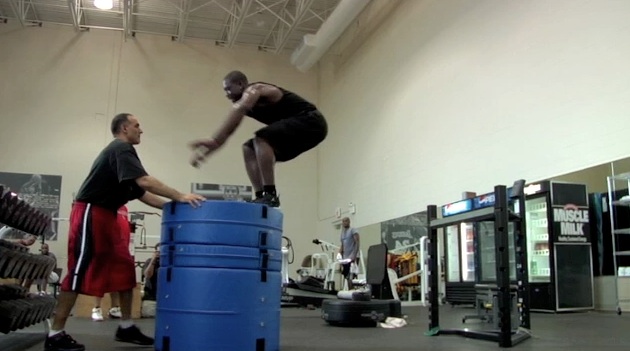Power Development, Part IV: Plyometric Training

Most power activities involve a counter movement during which the muscles are first stretched rapidly, then shortened to accelerate the body or limb—for example, lowering into a Squat Jump position for a Vertical Jump test. This movement is often called the “load phase,” and the muscle action is known as “plyometric contraction.”
Plyometric training increases overall neural stimulation of the muscles—how the brain sends signals to the muscles—and helps increase force output. Ground-based jumping is a good place to begin. Once you have a good understanding of the basic movements, you can progress to more advanced movements such as Depth Drops and Depth Jumps.
Below is a simple progression that can be used with almost any plyometric exercise.
1. Single Effort
• Perform one rep
• Stick the landing with good mechanics
• Reset and repeat
2. Double Effort
• Perform two reps
• Stick the landing with good mechanics
• Reset and repeat
3. Continuous Effort
• Perform all reps in a continuous fashion
• On the last rep, stick the landing with good mechanics
For example, let’s say you are going to perform Broad Jumps for three sets of six reps.
• Perform the first set as six “sets” of one rep, sticking the landing after each rep.
• Perform the second set as three sets of two reps, sticking the landing on every second rep.
• Perform the final set as one set of six reps, sticking the landing on the last rep.
Constantly stressing the importance of sticking the landing will teach you to remain under control and improve your ability to absorb force. This is extremely important when it comes to change of direction and agility.
Depth Drops/Jumps are also beneficial for power. Jump height will increase as drop height increases, but only to a point. If your Vertical Jump is 25 inches and you drop off a six-inch box, you should see your Vertical Jump numbers increase. But if you jump off a 36-inch box, your knees will buckle, your back will round and you’ll lose body control—and your Vertical Jump numbers will decrease. The golgi tendon reflex—a mechanism in the muscle that helps prevent overstretching, overworking and injury—inhibits this muscle action.
After a period of plyometric training, inhibitory effects are reduced because the body and muscles are used to taking on the load. Word of caution: Depth Drops are an advanced plyometric exercise. If you have not developed enough strength to handle absorbing this amount of force, injuries can occur. As a general rule, perform these types of drills after two to three years of training and start with low volume.
With plyometric training, as with many other training modalities, as you move toward your competition season, follow the progression of simple to complex [e.g., two-leg hops to single-leg jumps onto a box] and general to specific [e.g., two-leg cone hops for general to single-leg cone hops with sprint].
Previous posts:
Power Development, Part I
Power Development, Part II
Power Development, Part III
Kiel Holman is the executive director of Church of Iron in Indianapolis, where he also serves as throws coach for Lawrence Central High School. Certified by the CSCS, USAW, CrossFit L1, and USATF L1, he has worked with NFL defensive back Rashad Barksdale and UFC fighters Chris Lytle, Matt Mitrione and Jake O’Brien; and he has been a speaker at several coaching events, including USA Track and Field Elite Coach’s Camp, IATCCC State Clinic, National Throws Conference and Anderson University. Holman graduated from Ball State University, where he played four years of Division I baseball.
RECOMMENDED FOR YOU
MOST POPULAR
Power Development, Part IV: Plyometric Training

Most power activities involve a counter movement during which the muscles are first stretched rapidly, then shortened to accelerate the body or limb—for example, lowering into a Squat Jump position for a Vertical Jump test. This movement is often called the “load phase,” and the muscle action is known as “plyometric contraction.”
Plyometric training increases overall neural stimulation of the muscles—how the brain sends signals to the muscles—and helps increase force output. Ground-based jumping is a good place to begin. Once you have a good understanding of the basic movements, you can progress to more advanced movements such as Depth Drops and Depth Jumps.
Below is a simple progression that can be used with almost any plyometric exercise.
1. Single Effort
• Perform one rep
• Stick the landing with good mechanics
• Reset and repeat
2. Double Effort
• Perform two reps
• Stick the landing with good mechanics
• Reset and repeat
3. Continuous Effort
• Perform all reps in a continuous fashion
• On the last rep, stick the landing with good mechanics
For example, let’s say you are going to perform Broad Jumps for three sets of six reps.
• Perform the first set as six “sets” of one rep, sticking the landing after each rep.
• Perform the second set as three sets of two reps, sticking the landing on every second rep.
• Perform the final set as one set of six reps, sticking the landing on the last rep.
Constantly stressing the importance of sticking the landing will teach you to remain under control and improve your ability to absorb force. This is extremely important when it comes to change of direction and agility.
Depth Drops/Jumps are also beneficial for power. Jump height will increase as drop height increases, but only to a point. If your Vertical Jump is 25 inches and you drop off a six-inch box, you should see your Vertical Jump numbers increase. But if you jump off a 36-inch box, your knees will buckle, your back will round and you’ll lose body control—and your Vertical Jump numbers will decrease. The golgi tendon reflex—a mechanism in the muscle that helps prevent overstretching, overworking and injury—inhibits this muscle action.
After a period of plyometric training, inhibitory effects are reduced because the body and muscles are used to taking on the load. Word of caution: Depth Drops are an advanced plyometric exercise. If you have not developed enough strength to handle absorbing this amount of force, injuries can occur. As a general rule, perform these types of drills after two to three years of training and start with low volume.
With plyometric training, as with many other training modalities, as you move toward your competition season, follow the progression of simple to complex [e.g., two-leg hops to single-leg jumps onto a box] and general to specific [e.g., two-leg cone hops for general to single-leg cone hops with sprint].
Previous posts:
Power Development, Part I
Power Development, Part II
Power Development, Part III
Kiel Holman is the executive director of Church of Iron in Indianapolis, where he also serves as throws coach for Lawrence Central High School. Certified by the CSCS, USAW, CrossFit L1, and USATF L1, he has worked with NFL defensive back Rashad Barksdale and UFC fighters Chris Lytle, Matt Mitrione and Jake O’Brien; and he has been a speaker at several coaching events, including USA Track and Field Elite Coach’s Camp, IATCCC State Clinic, National Throws Conference and Anderson University. Holman graduated from Ball State University, where he played four years of Division I baseball.










